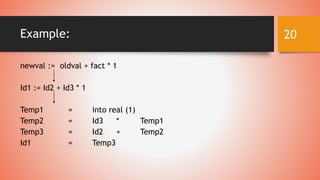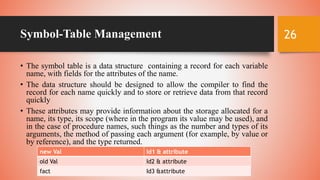Phases of Compiler
- 1. Introduction to Compiler Presented By: HIRA SHAHZAD JAVERIA KHALID TANZEELA HUSSAIN 1
- 2. • All computers only understand machine language • Therefore, high-level language instructions must be translated into machine language prior to execution 2 10000010010110100100101…… This is a program Why Use a compiler?
- 3. Compiler • A compiler is a large program that can read a program in one language the source language - and translate it into an equivalent program in another language - the target language; • An important role of the compiler is to report any errors in the source program that it detects during the translation process • If the target program is an executable machine-language program, it can then be called by the user to process inputs and produce outputs. 3 Source Program Compiler Target Program Error messages Output Input
- 4. Example Source Code Target Code 4
- 5. Interpreter An interpreter is another common kind of language processor. Instead of producing a target program as a translation, an interpreter appears to directly execute the operations specified in the source program or inputs supplied by the user The machine-language target program produced by a compiler is usually much faster than an interpreter at mapping inputs to outputs . An interpreter, however, can usually give better error diagnostics than a compiler, because it executes the source program statement by statement. 5 Source Program Interpreter Error messages Input Output
- 6. Working Process of Compilers Vs Interpreter Compilation Process: Interpretive Process: 6 Source program Data Object program Results Data Compiler Executing Computer Result Source program Interpreter Compile time Run time
- 7. Sr. Compiler Interpreter 1 Compiler Takes Entire program as input Interpreter Takes Single instruction as input . 2 Intermediate Object Code is Generated No Intermediate Object Code is Generated 3 Conditional Control Statements are Executes faster Conditional Control Statements are Executes slower 4 Memory Requirement : More(Since Object Code is Generated) Memory Requirement is Less 5 Program need not be compiled every time Every time higher level program is converted into lower level program 6 Errors are displayed after entire program is checked Errors are displayed for every instruction interpreted (if any) 7 Programming language like C, C++ use compilers. Programming language like Python, Ruby use interpreters. 7
- 8. Context of a Compiler • The programs which assist the compiler to convert a skeletal source code into executable form make the context of a compiler and is as follows: • Preprocessor: The preprocessor scans the source code and includes the header files which contain relevant information for various functions. • Compiler: The compiler passes the source code through various phases and generates the target assembly code. 8
- 9. Cont…. • Assembler: The assembler converts the assembly code into relocatable machine code or object code. Although this code is in 0 and 1 form, but it cannot be executed because this code has not been assigned the actual memory addresses. • Loader/Link Editor: It performs two functions. The process of loading consists of taking machine code, altering the relocatable addresses and placing the altered instructions and data in memory at proper location. The link editor makes a single program from several files of relocatable machine code. These files are library files which the program needs. The loader/link editor produces the executable or absolute machine code. 9
- 10. Phases of Compiler Design A compiler operates in phases. A phase is a logically interrelated operation that takes source program in one representation and produces output in another representation. The phases of a compiler are shown in below There are two phases of compilation. Analysis (Machine Independent/Language Dependent) Synthesis(Machine Dependent/Language independent) Compilation process is partitioned into no-of-sub processes called ‘phases’. 10
- 11. 11
- 12. Phase-1: Lexical Analysis • Lexical analyzer reads the stream of characters making up the source program and groups the characters into meaningful sequences called lexeme • For each lexeme, the lexical analyzer produces a token of the form that it passes on to the subsequent phase, syntax analysis (token-name, attribute-value) • Token-name: an abstract symbol is used during syntax analysis. • attribute-value: points to an entry in the symbol table for this token. 12
- 13. Example: newval := oldval + 12 Tokens: newval Identifier = Assignment operator oldval Identifier + Add operator 12 Number Lexical analyzer truncates white spaces and also removes errors. 13
- 14. 14
- 15. Phase-2: Syntax Analysis • Also called Parsing or Tokenizing. • The parser uses the first components of the tokens produced by the lexical analyzer to create a tree-like intermediate representation that depicts the grammatical structure of the token stream. • A typical representation is a syntax tree in which each interior node represents an operation and the children of the node represent the arguments of the operation 15
- 16. Example: 16
- 17. Phase-3: Semantic Analysis • The semantic analyzer uses the syntax tree and the information in the symbol table to check the source program for semantic consistency with the language definition. • Gathers type information and saves it in either the syntax tree or the symbol table, for subsequent use during intermediate-code generation. • An important part of semantic analysis is type checking, where the compiler checks that each operator has matching operands. • For example, many programming language definitions require an array index to be an integer; the compiler must report an error if a floating-point number is used to index an array. • Example: newval := oldval+12 The type of the identifier newval must match with the type of expression (oldval+12). 17
- 18. Example: • Semantic analysis • Syntactically correct, but semantically incorrect example: sum = a + b; int a; double sum; data type mismatch char b; Semantic records a integer sum double b char 18
- 19. Phase-4: Intermediate Code Generation After syntax and semantic analysis of the source program, many compilers generate an explicit low-level or machine-like intermediate representation (a program for an abstract machine). This intermediate representation should have two important properties: • it should be easy to produce and • it should be easy to translate into the target machine. The considered intermediate form called three-address code, which consists of a sequence of assembly-like instructions with three operands per instruction. Each operand can act like a register. This phase bridges the analysis and synthesis phases of translation. 19
- 20. Example: newval := oldval + fact * 1 Id1 := Id2 + Id3 * 1 Temp1 = into real (1) Temp2 = Id3 * Temp1 Temp3 = Id2 + Temp2 Id1 = Temp3 20
- 21. Phase-5: Code Optimization • The compiler looks at large segments of the program to decide how to improve performance • The machine-independent code-optimization phase attempts to improve the intermediate code so that better target code will result. • Usually better means: • faster, shorter code, or target code that consumes less power. • There are simple optimizations that significantly improve the running time of the target program without slowing down compilation too much. • Optimization cannot make an inefficient algorithm efficient - “only makes an efficient algorithm more efficient” 21
- 22. Example: • The above intermediate code will be optimized as: Temp1 = Id3 * 1 Id1 = Id2 + Temp1 22
- 23. Phase-6: Code Generation • The last phase of translation is code generation. • Takes as input an intermediate representation of the source program and maps it into the target language • If the target language is machine, code, registers or memory locations are selected for each of the variables used by the program. • Then, the intermediate instructions are translated into sequences of machine instructions that perform the same task. • A crucial aspect of code generation is the judicious assignment of registers to hold variables. 23
- 24. Example: Id1 := Id2 + Id3 * 1 MOV R1,Id3 MUL R1,#1 MOV R2,Id2 ADD R1,R2 MOV Id1,R1 24
- 25. 25
- 26. Symbol-Table Management • The symbol table is a data structure containing a record for each variable name, with fields for the attributes of the name. • The data structure should be designed to allow the compiler to find the record for each name quickly and to store or retrieve data from that record quickly • These attributes may provide information about the storage allocated for a name, its type, its scope (where in the program its value may be used), and in the case of procedure names, such things as the number and types of its arguments, the method of passing each argument (for example, by value or by reference), and the type returned. 26 new Val Id1 & attribute old Val Id2 & attribute fact Id3 &attribute
- 27. Error Handling Routine: • One of the most important functions of a compiler is the detection and reporting of errors in the source program. The error message should allow the programmer to determine exactly where the errors have occurred. Errors may occur in all or the phases of a compiler. • Whenever a phase of the compiler discovers an error, it must report the error to the error handler, which issues an appropriate diagnostic message. Both of the table-management and error-Handling routines interact with all phases of the compiler. 27
- 28. One pass compiler • One pass compiler passes through the source code of each compilation unit only once. • Their efficiency is limited because they don’t produce intermediate codes which can be refined easily. • One pass compilers very common because of their simplicity. • Check for semantic errors and generate code. • They are faster then multi pass compilers. • Also known as Narrow compiler. • Pascal and C are both languages that allow one pass compilation. 28
- 29. Multi-pass compilers • The input is passed through certain phases in one pass. Then the output of previous phases is passed through other phases in second pass and so on until the desired output is generated. • It requires less memory because each pass takes output of previous phase as input. • It may create one or more intermediate code. • Also known as wide compiler. • Modula-2 is a language whose structure requires that a compiler has at least two passes. 29
- 30. The phases of a compiler are collected into front end and back end. The FRONT END consists of those phases that depend primarily on the source program. These normally include Lexical and Syntactic analysis, Semantic analysis ,and the generation of intermediate code. A certain amount of code optimization can be done by front end as well. The BACK END includes the code optimization phase and final code generation phase, along with the necessary error handling and symbol table operations. The front end Analyzes the source program and produces intermediate code while the back end Synthesizes the target program from the intermediate code. Front End vs Back End of a Compilers 30
- 31. Cont…. The front end phase consists of those phases that primarily depend on source program and are independent of the target machine. Back end phase of compiler consists of those phases which depend on target machine and are independent of the source program. Intermediate representation may be considered as middle end, as it depends upon source code and target machine. 31
- 32. 32
- 33. 33
- 34. 34

































